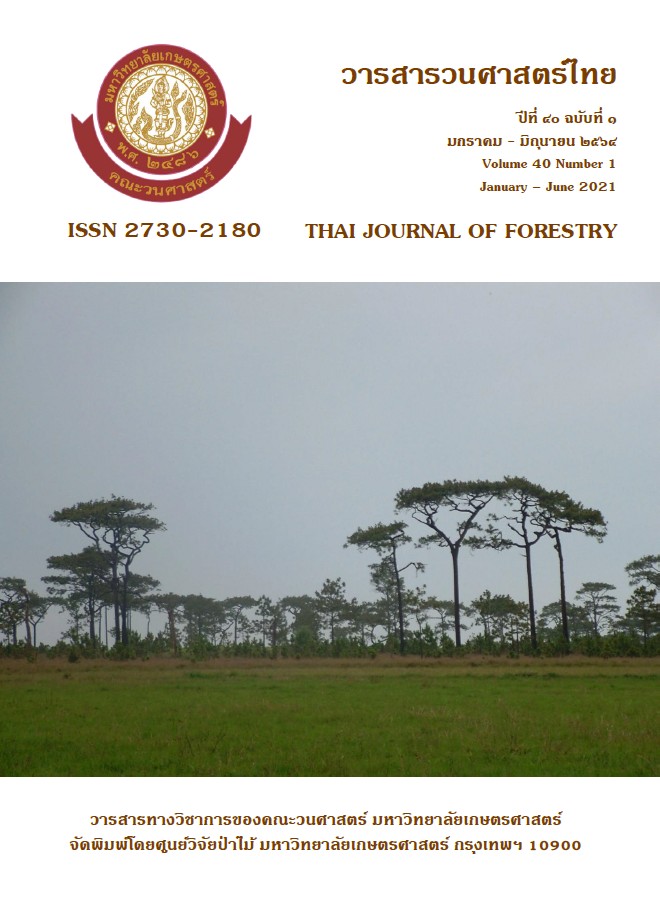ผลของการเปลี่ยนแปลงการใช้ที่ดินต่อการชะล้างพังทลายของดิน บริเวณลุ่มน้ำสาขายมตอนบน
Main Article Content
บทคัดย่อ
การศึกษาผลของการเปลี่ยนแปลงการใช้ที่ดินต่อการชะล้างพังทลายของดิน บริเวณลุ่มน้ำสาขายมตอนบน มีวัตถุประสงค์เพื่อศึกษาการเปลี่ยนแปลงการใช้ที่ดินช่วงระหว่างปี พ.ศ. 2550 ถึง 2561 และประยุกต์แบบจำลอง Dyna-CLUE ในการคาดการณ์การใช้ที่ดินในอนาคต โดยมีเงื่อนไขการขยายตัวของพื้นที่เกษตรกรรมเพิ่มขึ้นร้อยละ 3 ในพื้นที่ป่ารอสภาพฟื้นฟูและพื้นที่เบ็ดเตล็ดของพื้นที่ลุ่มน้ำ รวมทั้งจำลองสถานการณ์การใช้ที่ดินให้เหมาะสมกับชั้นคุณภาพลุ่มน้ำที่ 1 และ 2 โดยใช้โปรแกรมทางด้านระบบสารสนเทศภูมิศาสตร์ และสมการการสูญเสียดินสากล (USLE) ในการประเมินการชะล้างพังทลายของดินจากรูปแบบการใช้ที่ดินที่แตกต่างกัน ผลการศึกษาพบว่า พื้นที่ป่าลดลงมากที่สุด คิดเป็นร้อยละ 6.62 และในขณะที่พื้นที่เกษตรกรรมเพิ่มขึ้นร้อยละ 7.13 ของพื้นที่ทั้งหมด ผลของการคาดการณ์การใช้ที่ดินในอนาคตพบว่า พื้นที่ป่ารอสภาพฟื้นฟูลดลงและพื้นที่เกษตรกรรมเพิ่มขึ้น จากการจำลองสถานการณ์การใช้ที่ดินให้เหมาะสมกับชั้นคุณภาพลุ่มน้ำที่ 1 และ 2 ทำให้มีพื้นที่ป่าไม้ผลัดใบสมบูรณ์เพิ่มขึ้นร้อยละ 3.89 ของพื้นที่ทั้งหมด สำหรับการประเมินการชะล้างพังทลายของดินจากรูปแบบการใช้ที่ดินที่แตกต่างกัน พบว่า การใช้ที่ดินให้เหมาะสมกับชั้นคุณภาพลุ่มน้ำที่ 1 และ 2 พร้อมกับมีมาตรการอนุรักษ์ดินและน้ำรูปแบบ Terracing สามารถลดการชะล้างพังทลายของดินได้มากถึงร้อยละ 54.77 เมื่อเปรียบเทียบกับไม่มีมาตรการอนุรักษ์ดินและน้ำ
คำสำคัญ: การเปลี่ยนแปลงการใช้ที่ดิน การชะล้างพังทลายของดิน ลุ่มน้ำสาขายมตอนบน
Downloads
Article Details

อนุญาตภายใต้เงื่อนไข Creative Commons Attribution-NonCommercial-NoDerivatives 4.0 International License.
ข้าพเจ้าและผู้เขียนร่วม (ถ้ามี) ขอรับรองว่า ต้นฉบับที่เสนอมานี้ยังไม่เคยได้รับการตีพิมพ์และไม่ได้อยู่ในระหว่างกระบวนการพิจารณาตีพิมพ์ลงในวารสารหรือสิ่งตีพิมพ์อื่นใด ข้าพเจ้าและผู้เขียนร่วม (ถ้ามี) ยอมรับหลักเกณฑ์และเงื่อนไขการพิจารณาต้นฉบับ ทั้งยินยอมให้กองบรรณาธิการมีสิทธิ์พิจารณาและตรวจแก้ต้นฉบับได้ตามที่เห็นสมควร พร้อมนี้ขอมอบลิขสิทธิ์ผลงานที่ได้รับการตีพิมพ์ให้แก่วารสารวนศาสตร์ คณะวนศาสตร์ มหาวิทยาลัยเกษตรศาสตร์ กรณีมีการฟ้องร้องเรื่องการละเมิดลิขสิทธิ์เกี่ยวกับภาพ กราฟ ข้อความส่วนใดส่วนหนึ่ง หรือ ข้อคิดเห็นที่ปรากฏในผลงาน ให้เป็นความรับผิดชอบของข้าพเจ้าและผู้เขียนร่วม (ถ้ามี) แต่เพียงฝ่ายเดียว และหากข้าพเจ้าและผู้เขียนร่วม (ถ้ามี) ประสงค์ถอนบทความในระหว่างกระบวนการพิจารณาของทางวารสาร ข้าพเจ้าและผู้เขียนร่วม (ถ้ามี) ยินดีรับผิดชอบค่าใช้จ่ายทั้งหมดที่เกิดขึ้นในกระบวนการพิจารณาบทความนั้น”


